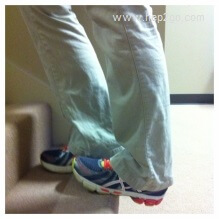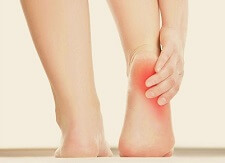- Home
- Common Foot Problems
- Haglund's Deformity
Haglunds Deformity
Written By: Chloe Wilson BSc(Hons) Physiotherapy
Reviewed By: FPE Medical Review Board
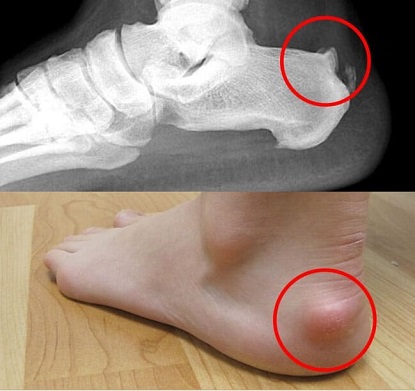
Haglunds Deformity is an enlargement of part of the bone on the back of the heel. It irritates the soft tissues around the Achilles tendon and causes heel pain.
Haglund's deformity is also known as "Pump Bump" or "Mulhulland Deformity".
It is commonly associated with other conditions such as heel bursitis and achilles tendonitis as it causes friction on the surrounding soft tissues.
You may be genetically disposed to Haglunds Deformity by your foot shape, or it can be caused by muscle tightness or friction from shoes.
Here, we will look at the causes, symptoms, associated problems and treatment options for these uncomfortable heel bone spurs.
What Is A Haglund's Deformity?
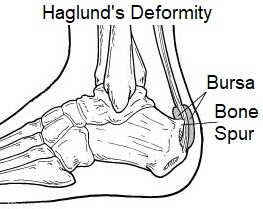
With Haglund's Deformity, friction over the back of the heel causes the formation of bone spurs on the heel as the body lays down extra layers of bone to try and protect itself.
The Achilles tendon runs down the back of the calf and attaches to the back of the heel bone, the calcaneus. A bursa, a small fluid filled sac, sits in between the tendon and the heel bone to help prevent friction and allow the tendon to move smoothly.
The bony prominence associated with Haglunds Deformity places excessive pressure on the bursa and it becomes inflamed, known as bursitis. This can be extremely painful.
What Causes Haglunds Deformity?
The most common causes of Haglunds Deformity are:
- Footwear: The most common cause of Haglund's Deformity is footwear. Shoes with rigid backs, like pumps, ice skates and high heels place excessive pressure on the back of the heel, hence the alternative name for this condition, pump bump. This can result in the formation of heel bone spurs, forming the characteristic lump.
- Genetics: People with high foot arches are more prone to developing Haglund's Deformity as it causes the calcaneus to tip backwards increasing the pressure around the Achilles region
- Muscle Tightness: Tightness in the calf muscle places more tension on the Achilles tendon which increases the pressure on the bursa
- Walking Pattern: People who tend to walk on the outside of their feet are more likely to suffer from Pump Bump as it subtly changes the position of the heel bone increasing the friction under the Achilles tendon.
Symptoms of Pump Bump
The most common symptoms of Haglunds Deformity are:
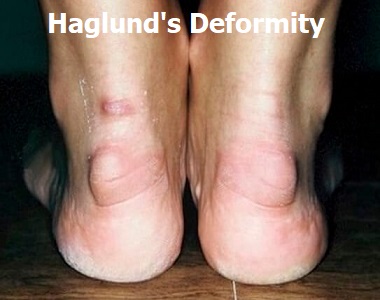
- Hard Lump: found on the back of the heel, that develops gradually over time.
- Swelling: there is often noticeable swelling around the back of the heel
- Redness: The back of the heel may look slightly red due to the inflammation of the bursa
- Heel Pain: pain is usually felt at the back of the heel around the Achilles tendon. It tends to be quite localised
The symptoms of Haglunds deformity tend to develop slowly over time rather than suddenly, gradually increasing in severity. A Haglund's deformity is one of the most common causes of heel lumps.
Treatment For Haglund's Deformity
Treatment for Haglunds Deformity initially aims to reduce the inflammation in the bursa and will depend on what caused the condition to develop in the first place:
- Stretches: Calf stretches helps reduce the tightness and tension in the Achilles tendon and are a great way to treat and prevent this condition. You can suitable exercises in the calf stretches section
- Ice: Ice can be used to help reduce the pain and inflammation around the area. Find out how to safely and effectively use ice in the Ice Therapy section
- Medication: NSAIDs (non-steroidal anti-inflammatory drugs) can be used to reduce the pain and inflammation associated with Haglund's Deformity. Some people prefer to use the cream form and rub it into the back of the heel instead of taking pills. Always check with your doctor before taking any medications
- Footwear: Wearing backless, soft-backed shoes or going barefoot helps reduce the friction around the area and is one of the best ways to treat of prevent Pump Bump
- Heel Pads: You can place soft orthotic pads on the back lip of your shoe to cushion the heel, or underneath the heel to lift it up and reduce the pressure when walking
- Physical Therapy: Treatment such as ultrasound can help to reduce the inflammation associated with bursitis
- Changing Activities: Avoiding running on hard surface and keeping on the flat rather than going uphill can help prevent Haglund's Deformity
Often, these treatments are enough to cure the pain and inflammation associated with pump bump, although there may still be a lump on the back of the heel.
If symptoms persist, surgery may be required. Most commonly, as small incision is made and the surgeon removes the heel bone spurs, leaving a nice, flat surface. Sometimes, they may also have to remove the bursa and part of the Achilles tendon. You may need to use crutches for a few days following surgery.
Your Questions Answered
How Long Is Recovery From Haglunds Deformity? Pain from Haglunds Deformity usually settles down within around 3 months with non-operative treatment. It is really important to rest from aggravating activities and avoid wearing shoes which rub on the pump bump. If symptoms of Haglunds Deformity persist for more than a few months with appropriate treatment, then surgery may be advised
Does Haglund's Deformity Go Away? As associated problems such as heel bursitis settle, the size of the lump should reduce, but the bony lump of Haglunds deformity may never completely go without surgery. As long as there are no other symptoms, the pump bump is not usually a problem.
Will I Need Surgery? Only around 10% of people with Haglund's Deformity will require surgery. Most people will recovery with a combination of rest, exercises, orthotics, changing footwear, ice and medication
How Long Does It Take To Recover From Haglunds Surgery? It can take 6-12 months to fully recovery from a Haglunds Resection. You will be given a walking boot to wear and crutches initially and will likely be non or partial weightbearing (minimal weight on your foot when walking) for the first 2-4 weeks after surgery. People usually return to work after 8-12 weeks depending on their job, and return to sports after 3-4 months.
Why Is It Called Haglunds Deformity? Pump bump is named after Patrick Haglund, a Swedish Orthopedic Surgeon, who first described the condition back in 1927.
Can You Have A Bunion On Your Heel? A hard bony lump on the back of the heel is typcially referred to as Haglunds Deformity, but is sometimes described as a heel bunion. The outgrowth of bone with Haglunds Deformity is similar to that of a bunion, but there is no change in the position of the heel bone as seen in toe bunions.
What Does Pump Bump Look Like? Someone with pump bump will have a hard lump over the back of their heel, usually level with the top of their shoe. The area may also be swollen and red.
What Else Can Help?
If you are getting pain around the back of the heel, but it is not sounding quite like Haglunds Deformity, it may be that you have a problem in the Achilles tendon – visit the Achilles Tendonitis section to find out about the common causes, symptoms and treatment options for this common cause of heel pain.
Alternatively, visit the heel pain diagnosis section or the heel lumps & bumps article for help working out what is causing your pain.
You may also be interested in the following articles:
- Pain On Top Of Foot
- Foot Arch Pain
- Nerve Pain In The Foot
- Foot & Ankle Stretches
- Swollen Feet & Ankles
- Foot Numbness
Related Articles
Page Last Updated: 05/23/25
Next Review Due: 05/23/25
